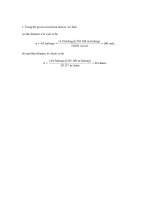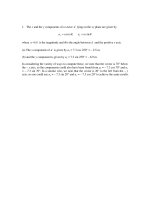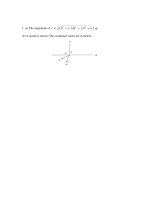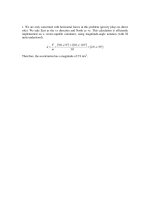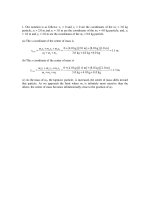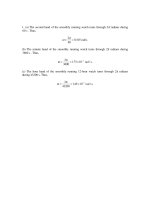Solution manual fundamentals of physics extended, 8th editionch06
Bạn đang xem bản rút gọn của tài liệu. Xem và tải ngay bản đầy đủ của tài liệu tại đây (1.1 MB, 118 trang )
1. An excellent discussion and equation development related to this problem is given in
Sample Problem 6-3. We merely quote (and apply) their main result (Eq. 6-13)
θ = tan − 1 µ s = tan − 1 0.04 ≈ 2° .
&
2. The free-body diagram for the player is shown next. FN is the normal force of the
&
&
ground on the player, mg is the force of gravity, and f is the force of friction. The force
of friction is related to the normal force by f = µkFN. We use Newton’s second law
applied to the vertical axis to find the normal force. The vertical component of the
acceleration is zero, so we obtain FN – mg = 0; thus, FN = mg. Consequently,
µk =
f
FN
470 N
( 79 kg ) ( 9.8 m/s 2 )
= 0.61.
=
3. We do not consider the possibility that the bureau might
tip, and treat this as a purely
&
horizontal motion problem (with the person’s push F in the +x direction). Applying
Newton’s second law to the x and y axes, we obtain
F − f s , max = ma
FN − mg = 0
respectively. The second equation yields the normal force FN = mg, whereupon the
maximum static friction is found to be (from Eq. 6-1) f s ,max = µ s mg . Thus, the first
equation becomes
F − µ s mg = ma = 0
where we have set a = 0 to be consistent with the fact that the static friction is still (just
barely) able to prevent the bureau from moving.
(a) With µ s = 0.45 and m = 45 kg, the equation above leads to F = 198 N. To bring the
bureau into a state of motion, the person should push with any force greater than this
value. Rounding to two significant figures, we can therefore say the minimum required
push is F = 2.0 × 102 N.
(b) Replacing m = 45 kg with m = 28 kg, the reasoning above leads to roughly
F = 1.2 × 10 2 N .
4. To maintain the stone’s motion, a horizontal force (in the +x direction) is needed that
cancels the retarding effect due to kinetic friction. Applying Newton’s second to the x
and y axes, we obtain
F − f k = ma
FN − mg = 0
respectively. The second equation yields the normal force FN = mg, so that (using Eq. 6-2)
the kinetic friction becomes fk = µk mg. Thus, the first equation becomes
F − µ k mg = ma = 0
where we have set a = 0 to be consistent with the idea that the horizontal velocity of the
stone should remain constant. With m = 20 kg and µk = 0.80, we find F = 1.6 × 102 N.
&
5. We denote F as the horizontal force of the person exerted on the crate (in the +x
&
direction), f k is the force of kinetic friction (in the –x direction), FN is the vertical
&
normal force exerted by the floor (in the +y direction), and mg is the force of gravity.
The magnitude of the force of friction is given by fk = µkFN (Eq. 6-2). Applying Newton’s
second law to the x and y axes, we obtain
F − f k = ma
FN − mg = 0
respectively.
(a) The second equation yields the normal force FN = mg, so that the friction is
b gb
f k = µ k mg = 0.35 55 kg
g c9.8 m / s h = 1.9 × 10
2
(b) The first equation becomes
F − µ k mg = ma
which (with F = 220 N) we solve to find
a=
F
− µ k g = 0.56 m / s2 .
m
2
N.
6. The greatest deceleration (of magnitude a) is provided by the maximum friction force
(Eq. 6-1, with FN = mg in this case). Using Newton’s second law, we find
a = fs,max /m = µsg.
Eq. 2-16 then gives the shortest distance to stop: |∆x| = v2/2a = 36 m. In this calculation,
it is important to first convert v to 13 m/s.
7. We choose +x horizontally rightwards and +y upwards and observe that the 15 N force
has components Fx = F cos θ and Fy = – F sin θ.
(a) We apply Newton’s second law to the y axis:
FN − F sin θ − mg = 0 FN = (15) sin 40 ° + (3.5) (9.8) = 44 N.
With µk = 0.25, Eq. 6-2 leads to fk = 11 N.
(b) We apply Newton’s second law to the x axis:
F cos θ − f k = ma a =
(15) cos 40° − 11
3.5
= 0.14 m/s 2 .
Since the result is positive-valued, then the block is accelerating in the +x (rightward)
direction.
8. We first analyze the forces on the pig of mass m. The incline angle is θ.
The +x direction is “downhill.’’
Application of Newton’s second law to the x- and y-axes leads to
mg sin θ − f k = ma
FN − mg cos θ = 0.
Solving these along with Eq. 6-2 (fk = µkFN) produces the following result for the pig’s
downhill acceleration:
b
g
a = g sin θ − µ k cos θ .
To compute the time to slide from rest through a downhill distance " , we use Eq. 2-15:
" = v0 t +
1 2
at t =
2
2"
.
a
We denote the frictionless (µk = 0) case with a prime and set up a ratio:
t
=
t′
2" / a
=
2" / a ′
a′
a
which leads us to conclude that if t/t' = 2 then a' = 4a. Putting in what we found out
above about the accelerations, we have
b
g
g sin θ = 4 g sin θ − µ k cos θ .
Using θ = 35°, we obtain µk = 0.53.
9. Applying Newton’s second law to the horizontal motion, we have F − µk m g = ma,
where we have used Eq. 6-2, assuming that FN = mg (which is equivalent to assuming
that the vertical force from the broom is negligible). Eq. 2-16 relates the distance traveled
and the final speed to the acceleration: v2 = 2a∆x. This gives a = 1.4 m/s2. Returning to
the force equation, we find (with F = 25 N and m = 3.5 kg) that µk = 0.58.
10. In addition to the forces already shown in Fig. 6-22, a free-body diagram would
&
&
include an upward normal force FN exerted by the floor on the block, a downward mg
&
representing the gravitational pull exerted by Earth, and an assumed-leftward f for the
kinetic or static friction. We choose +x rightwards and +y upwards. We apply Newton’s
second law to these axes:
F − f = ma
P + FN − mg = 0
where F = 6.0 N and m = 2.5 kg is the mass of the block.
(a) In this case, P = 8.0 N leads to FN = (2.5)(9.8) – 8.0 = 16.5 N. Using Eq. 6-1, this
implies f s ,max = µ s FN = 6.6 N , which is larger than the 6.0 N rightward force – so the
block (which was initially at rest) does not move. Putting a = 0 into the first of our
equations above yields a static friction force of f = P = 6.0 N.
(b) In this case, P = 10 N, the normal force is FN = (2.5)(9.8) – 10 = 14.5 N. Using Eq. 61, this implies f s ,max = µ s FN = 5.8 N , which is less than the 6.0 N rightward force – so the
block does move. Hence, we are dealing not with static but with kinetic friction, which
Eq. 6-2 reveals to be f k = µ k FN = 3.6 N .
(c) In this last case, P = 12 N leads to FN = 12.5 N and thus to f s ,max = µ s FN = 5.0 N ,
which (as expected) is less than the 6.0 N rightward force – so the block moves. The
kinetic friction force, then, is f k = µ k FN = 3.1 N .
11. We denote the magnitude of 110 N force exerted by the worker on the crate as F. The
magnitude of the static frictional force can vary between zero and f s ,max = µ s FN .
(a) In this case, application of Newton’s second law in the vertical direction yields
FN = mg . Thus,
f s , max = µ s FN = µ s mg = ( 0.37 ) ( 35kg ) ( 9.8m / s 2 ) = 1.3 ×102 N
which is greater than F.
(b) The block, which is initially at rest, stays at rest since F < fs, max. Thus, it does not
move.
(c) By applying Newton’s second law to the horizontal direction, that the magnitude of
the frictional force exerted on the crate is f s = 1.1× 102 N .
(d) Denoting the upward force exerted by the second worker as F2, then application of
Newton’s second law in the vertical direction yields FN = mg – F2, which leads to
f s ,max = µ s FN = µ s (mg − F2 ) .
In order to move the crate, F must satisfy the condition F > fs,max = µs (mg − F2)
or
110 N > ( 0.37 ) ª¬(35 kg)(9.8 m/s 2 ) − F2 º¼ .
The minimum value of F2 that satisfies this inequality is a value slightly bigger than
45.7 N , so we express our answer as F2, min = 46 N.
(e) In this final case, moving the crate requires a greater horizontal push from the worker
than static friction (as computed in part (a)) can resist. Thus, Newton’s law in the
horizontal direction leads to
F + F2 > f s , max
110 N + F2 > 126.9 N
which leads (after appropriate rounding) to F2, min = 17 N.
12. There is no acceleration, so the (upward) static friction forces (there are four of them,
one for each thumb and one for each set of opposing fingers) equals the magnitude of the
(downward) pull of gravity. Using Eq. 6-1, we have
4 µ s FN = mg = (79 kg)(9.8 m/s 2 )
which, with µs = 0.70, yields FN = 2.8 × 102 N.
&
13. (a) The free-body diagram for the crate is shown below. T is the tension force of the
&
&
rope on the crate, FN is the normal force of the floor on the crate, mg is the force of
&
gravity, and f is the force of friction. We take the +x direction to be horizontal to the
right and the +y direction to be up. We assume the crate is motionless. The equations for
the x and the y components of the force according to Newton’s second law are:
T cos θ – f = 0
T sin θ + FN − mg = 0
where θ = 15° is the angle between the rope and the horizontal. The first equation gives f
= T cos θ and the second gives FN = mg – T sin θ. If the crate is to remain at rest, f must
be less than µs FN, or T cos θ < µs (mg – T sinθ). When the tension force is sufficient to
just start the crate moving, we must have
T cos θ = µs (mg – T sin θ).
We solve for the tension:
T=
=
µ s mg
cos θ + µ s sin θ
( 0.50 ) ( 68) ( 9.8 )
cos 15° + 0.50 sin 15°
= 304 ≈ 3.0 ×102 N.
(b) The second law equations for the moving crate are
T cos θ – f = ma
FN + T sin θ – mg = 0.
Now f =µkFN, and the second equation gives FN = mg – Tsinθ, which yields
f = µ k (mg − T sin θ ) . This expression is substituted for f in the first equation to obtain
T cos θ – µk (mg – T sin θ) = ma,
so the acceleration is
a=
Numerically, it is given by
T ( cos θ + µk sin θ )
− µk g .
m
a=
b304 Ngbcos15° + 0.35 sin 15°g − b0.35gc9.8 m / s h = 13. m / s .
2
68 kg
2
14. (a) Although details in Fig. 6-24 might suggest otherwise, we assume (as the problem
states) that only static friction holds block B in place. An excellent discussion and
equation development related to this topic is given in Sample Problem 6-3. We merely
quote (and apply) their main result (Eq. 6-13) for the maximum angle
for which static
&
friction applies (in the absence of additional forces such as the F of part (b) of this
problem).
θ max = tan −1 µ s = tan −1 0.63 ≈ 32° .
This is greater than the dip angle in the problem, so the block does not slide.
(b) We analyze forces in a manner similar to that shown in Sample Problem 6-3, but with
the addition of a downhill force F.
F + mg sin θ − f s , max = ma = 0
FN − mg cos θ = 0.
Along with Eq. 6-1 (fs, max = µsFN) we have enough information to solve for F. With
θ = 24° and m = 1.8 × 107 kg, we find
b
g
F = mg µ s cos θ − sin θ = 3.0 × 107 N .
15. (a) The free-body diagram for the block is
&
&
shown below. F is the applied force, FN is the
&
normal force of the wall on the block, f is the
&
force of friction, and mg is the force of gravity.
To determine if the block falls, we find the
magnitude f of the force of friction required to
hold it without accelerating and also find the
normal force of the wall on the block.
We compare f and µsFN. If f < µsFN, the block does not slide on the wall but if f > µsFN,
the block does slide. The horizontal component of Newton’s second law is F –FN = 0, so
FN = F = 12 N and µsFN = (0.60)(12 N) = 7.2 N. The vertical component is f – mg = 0, so
f = mg = 5.0 N. Since f < µsFN the block does not slide.
(b) Since the block does not move f = 5.0 N and FN = 12 N. The force of the wall on the
block is
&
Fw = − FN ˆi + f ˆj = − (12N ) ˆi + ( 5.0N ) ˆj
where the axes are as shown on Fig. 6-25 of the text.
16. We find the acceleration from the slope of the graph (recall Eq. 2-11): a = 4.5 m/s2.
The forces are similar to what is discussed in Sample Problem 6-2 but with the angle φ
equal to 0 (the applied force is horizontal), and in this problem the horizontal acceleration
is not zero. Thus, Newton’s second law leads to
F – µk mg = ma,
where F = 40.0 N is the constant horizontal force applied. With m = 4.1 kg, we arrive at
µk =0.54.
17. Fig. 6-4 in the textbook shows a similar situation (using φ for the unknown angle)
along with a free-body diagram. We use the same coordinate system as in that figure.
(a) Thus, Newton’s second law leads to
T cos φ − f = ma along x axis
T sin φ + FN − mg = 0 along y axis
Setting a = 0 and f = fs,max = µsFN, we solve for the mass of the box-and-sand (as a
function of angle):
m=
FG
H
T
cos φ
sin φ +
g
µs
IJ
K
which we will solve with calculus techniques (to find the angle φ m corresponding to the
maximum mass that can be pulled).
FG
H
IJ
K
sin φ m
dm T
=
cos φ m −
=0
dt
g
µs
This leads to tan φ m = µ s which (for µ s = 0.35 ) yields φ m = 19° .
(b) Plugging our value for φ m into the equation we found for the mass of the box-andsand yields m = 340 kg. This corresponds to a weight of mg = 3.3 × 103 N.
18. (a) Refer to the figure in the textbook accompanying Sample Problem 6-3 (Fig. 6-5).
Replace fs with fk in Fig. 6-5(b) and set θ = 12.0º, we apply Newton’s second law to the
“downhill” direction:
mg sinθ – f = ma,
where, using Eq. 6-12,
f = fk = µkFN = µk mg cosθ .
Thus, with µk = 0.600, we have
a = gsinθ – µk cosθ = –3.72 m/s2
which means, since we have chosen the positive direction in the direction of motion
[down the slope] then the acceleration vector points “uphill”; it is decelerating. With
v0 = 18.0 m/s and ∆x = d = 24.0 m, Eq. 2-16 leads to
v = v02 + 2ad = 12.1 m/s.
(b) In this case, we find a = +1.1 m/s2, and the speed (when impact occurs) is 19.4 m/s.
19. If the block is sliding then we compute the kinetic friction from Eq. 6-2; if it is not
sliding, then we determine the extent of static friction from applying Newton’s law, with
zero acceleration, to the x axis (which is parallel to the incline surface). The question of
whether or not it is sliding is therefore crucial, and depends on the maximum static
friction force, as calculated from Eq. 6-1. The forces are resolved in the incline plane
coordinate system in Figure 6-5 in the textbook. The acceleration, if there is any, is along
the x axis, and we are taking uphill as +x. The net force along the y axis, then, is certainly
zero, which provides the following relationship:
&
F
¦ y = 0 FN = W cos θ
where W = mg = 45 N is the weight of the block, and θ = 15° is the incline angle. Thus,
FN = 43.5 N, which implies that the maximum static friction force should be
fs,max = (0.50) (43.5) = 21.7 N.
&
(a) For P = (− 5.0 N)iˆ , Newton’s second law, applied to the x axis becomes
f − | P | − mg sin θ = ma .
&
Here we are assuming f is pointing uphill, as shown in Figure 6-5, and if it turns out that
it points downhill (which is a possibility), then the result for fs will be negative. If f = fs
then a = 0, we obtain
fs = | P | + mg sinθ = 5.0 + (43.5)sin15° =17 N,
&
or f s = (17 N)iˆ . This is clearly allowed since f s is less than fs, max.
&
&
(b) For P = (− 8.0 N)iˆ , we obtain (from the same equation) f s = (20 N)iˆ , which is still
allowed since it is less than fs, max.
&
(c) But for P = (− 15 N)iˆ , we obtain (from the same equation) fs = 27 N, which is not
allowed since it is larger than fs, max. Thus, we conclude that it is the kinetic friction
instead of the static friction that is relevant in this case. The result is
&
f k = µk FN ˆi = (0.34)(43.5 N) ˆi = (15 N) ˆi .
20. We use coordinates and weight-components as indicated in Fig. 5-18 (see Sample
Problem 5-7 from the previous chapter).
&
(a) In this situation, we take f s to point uphill and to be equal to its maximum value, in
which case fs, max = µ s FN applies, where µs = 0.25. Applying Newton’s second law to the
block of mass m = W/g = 8.2 kg, in the x and y directions, produces
Fmin 1 − mg sin θ + f s , max = ma = 0
FN − mg cos θ = 0
which (with θ = 20°) leads to
Fmin 1 − mg ( sin θ + µ s cos θ ) = 8.6 N.
&
(b) Now we take f s to point downhill and to be equal to its maximum value, in which
case fs, max = µsFN applies, where µs = 0.25. Applying Newton’s second law to the block
of mass m = W/g = 8.2 kg, in the x and y directions, produces
Fmin 2 = mg sin θ − f s , max = ma = 0
FN − mg cos θ = 0
which (with θ = 20°) leads to
b
g
Fmin 2 = mg sin θ + µ s cos θ = 46 N.
A value slightly larger than the “exact” result of this calculation is required to make it
accelerate uphill, but since we quote our results here to two significant figures, 46 N is a
“good enough” answer.
(c) Finally, we are dealing with kinetic friction (pointing downhill), so that
F − mg sin θ − f k = ma = 0
FN − mg cos θ = 0
along with fk = µkFN (where µk = 0.15) brings us to
b
g
F = mg sin θ + µ k cos θ = 39 N .
21. The
& free-body diagrams for block B and for the knot just above block A are shown
next. T1 is the tension force of the rope pulling on block B or pulling on the knot (as the
&
case may be), T2 is the tension force exerted by the second rope (at angle θ = 30°) on the
&
&
knot, f is the force of static friction exerted by the horizontal surface on block B, FN is
normal force exerted by the surface on block B, WA is the weight of block A (WA is the
&
magnitude of mA g ), and WB is the weight of block B (WB = 711 N is the magnitude of
&
mB g ).
For each object we take +x horizontally rightward and +y upward. Applying Newton’s
second law in the x and y directions for block B and then doing the same for the knot
results in four equations:
T1 − f s ,max
FN − WB
T2 cos θ − T1
T2 sin θ − WA
=
=
=
=
0
0
0
0
where we assume the static friction to be at its maximum value (permitting us to use Eq.
6-1). Solving these equations with µs = 0.25, we obtain WA = 103 N ≈ 1.0 × 10 2 N .
22. Treating the two boxes as a single system of total mass mC + mW =1.0 + 3.0 = 4.0 kg,
subject to a total (leftward) friction of magnitude 2.0 + 4.0 = 6.0 N, we apply Newton’s
second law (with +x rightward):
F − f total = mtotal a
12.0 − 6.0 = (4.0)a
which yields the acceleration a = 1.5 m/s2. We have treated F as if it were known to the
nearest tenth of a Newton so that our acceleration is “good” to two significant figures.
Turning our attention to the larger box (the Wheaties box of mass mW = 3.0 kg) we apply
Newton’s second law to find the contact force F' exerted by the Cheerios box on it.
F ′ − f W = mW a
F ′ − 4.0 = (3.0)(1.5)
This yields the contact force F' = 8.5 N.
23. Let the tensions on the strings connecting m2 and m3 be T23, and that connecting m2
and m1 be T12, respectively. Applying Newton’s second law (and Eq. 6-2, with FN = m2g
in this case) to the system we have
m3 g − T23 = m3 a
T23 − µ k m2 g − T12 = m2 a
T12 − m1 g = m1a
Adding up the three equations and using m1 = M , m2 = m3 = 2M , we obtain
2Mg – 2µk Mg – Mg = 5Ma .
With a = 0.500 m/s2 this yields µk = 0.372. Thus, the coefficient of kinetic friction is
roughly µk = 0.37.
24. (a) Applying Newton’s second law to the system (of total mass M = 60.0 kg) and
using Eq. 6-2 (with FN = Mg in this case) we obtain
F – µkMg = Ma a= 0.473 m/s2.
Next, we examine the forces just on m3 and find F32 = m3(a + µkg) = 147 N. If the
algebra steps are done more systematically, one ends up with the interesting relationship:
F32 = (m3 / M ) F (which is independent of the friction!).
(b) As remarked at the end of our solution to part (a), the result does not depend on the
frictional parameters. The answer here is the same as in part (a).
